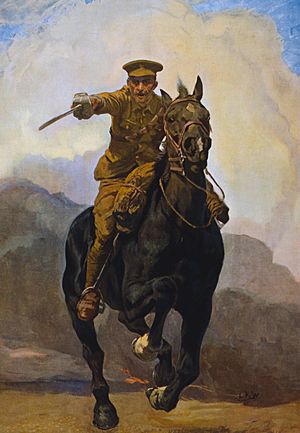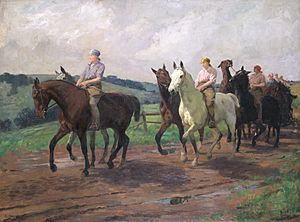Lucy Kemp-Welch facts for kids
Quick facts for kids
Lucy Kemp-Welch
|
|
|---|---|
 |
|
| Born | 20 June 1869 |
| Died | 27 November 1958 (aged 89) |
| Nationality | British |
| Education | The Herkomer School |
| Known for | Equine artist |
Lucy Elizabeth Kemp-Welch (born June 20, 1869 – died November 27, 1958) was a British artist and teacher. She was famous for painting horses. From the late 1890s to the mid-1920s, she was one of Britain's most well-known female artists.
Lucy Kemp-Welch was often compared to the French artist Rosa Bonheur. Only Lady Elizabeth Butler was more famous in her time. Today, Lucy Kemp-Welch is best known for her large paintings of wild horses. She also painted working horses in the New Forest. During World War One, she painted horses used by the military. She also drew pictures for the 1915 book Black Beauty by Anna Sewell.
Contents
Biography
Early Life and Art School
Lucy Kemp-Welch was born in Bournemouth. Her father, Edwin Buckland Kemp-Welch, was a lawyer. Lucy showed a great talent for art from a young age. She had her first art show when she was 14.
In 1891, Lucy and her younger sister Edith moved to Bushey. They went to Hubert von Herkomer’s art school there. Lucy was one of Herkomer's best students. She was able to set up her own art studio.
In 1905, Lucy Kemp-Welch took over the Herkomer School. She ran it until 1926. She first called it the Bushey School of Painting. Later, she moved it to her home and called it the Kemp-Welch School of Animal Painting.
Early Success as an Artist
While still a student, Lucy had a painting shown at the Royal Academy. This was in 1895. The painting was called Gypsy Drovers taking Horses to a Fair.
In 1897, her painting Colt-Hunting in the New Forest was also shown at the Royal Academy. This painting was bought for a large sum of money. It is now in the Tate art museum. Lucy Kemp-Welch had 61 paintings shown at the Royal Academy during her career.
In 1902, Lucy became a member of the Royal Society of British Artists. She and Louise Jopling were the first women to join. In 1914, she became the president of the Society of Animal Painters.
In 1915, she drew pictures for a special edition of Anna Sewell's book Black Beauty. She used Robert Baden-Powell's horse, Black Prince, as a model. Besides horses, she also painted other animals, flowers, and landscapes. She painted scenes from the Boer War too. These paintings showed horses in military action. This led to important jobs for her during World War One.
World War One Art
In December 1914, Lucy Kemp-Welch was asked to create a poster. It was for the British army to encourage people to join. The famous poster was called Forward! Forward to Victory Enlist Now. She signed it 'L.K.W 1914.'
During World War One, women helped train horses for the army. The Imperial War Museum asked Lucy to paint a scene. It was at Russley Park in Wiltshire, a large horse training center run by women. Lucy painted The Straw-Ride- Russley Park, Remount Depot Wiltshire. She gave this painting to the museum for free.
In 1916, Lucy visited the Royal Field Artillery camp at Bulford. This was on Salisbury Plain. She was allowed to set up her easel. Horse artillery teams rode towards her. This let her sketch the horses moving up close.
These sketches led to two large paintings. One was The Leaders of a Heavy Gun Team. The other was Forward the Guns. These paintings were shown at the Royal Academy in 1917. Forward the Guns was bought by the Tate museum.
Lucy also made studies at other army camps. She painted Big Guns to the Front. This picture showed large horses pulling guns through snow. It was very popular at the Royal Academy in 1918. It was bought by the National Museum of Wales in Cardiff in 1921.
Later Life and Legacy
In 1924, Lucy Kemp-Welch created a large painting for the Royal Exchange. It honored the work of women during World War One.
From 1926, she focused on painting scenes of gypsy and circus life. She spent several summers with Sanger's Circus. She painted their horses.
Lucy Kemp-Welch lived in Bushey, Hertfordshire, for most of her life. She never married. A large collection of her artworks is kept at the Bushey Museum. These include paintings of wild ponies on Exmoor. She also painted galloping polo ponies. Other works show a lifeboat being pulled into the sea by horses. She also painted heavy working horses pulling timber and farm horses coming home.
Family
Lucy Kemp-Welch's younger sister, Edith, was also an artist. Their cousin, Margaret Kemp-Welch (1874–1968), was also an artist. Edith Kemp-Welch also made a poster for the British war effort. It showed Britannia with the words "Remember Scarborough".
Lucy's close friend, Marguerite Frobisher, was buried with her when she died in 1974.
See also
 In Spanish: Lucy Kemp-Welch para niños
In Spanish: Lucy Kemp-Welch para niños




